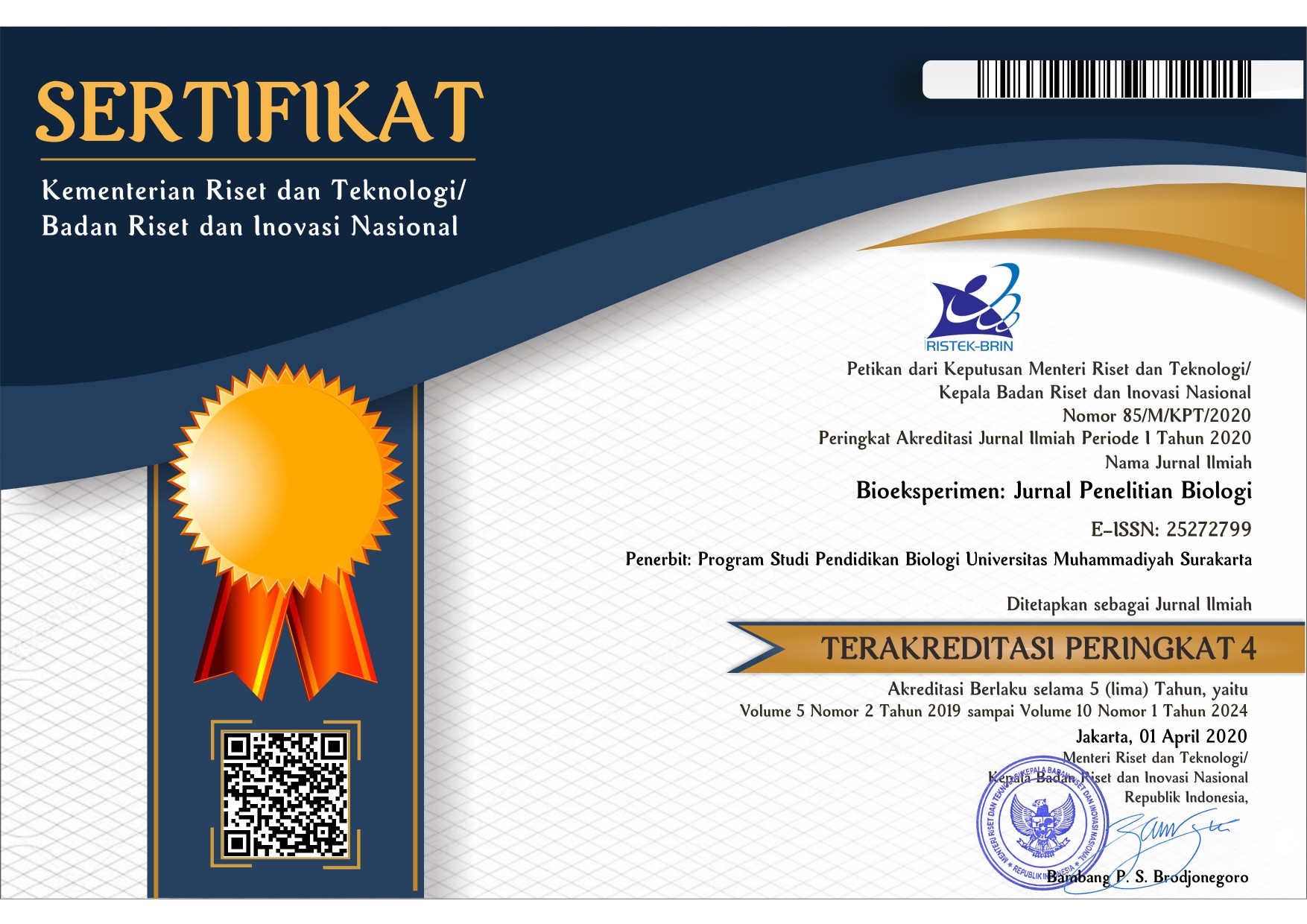Biomassa di Atas Tanah dan Penghitungan Simpanan Karbon Hutan Kalibiru Kabupaten Kulon Progo
Andy Arsalan(1*), Evi Gravitiani(2), Heru Irianto(3)(1)
(2) Fakultas Ekonomi dan Bisnis Universitas Sebelas Maret
(3) Fakultas Pertanian Jurusan Agribisnis Universitas Sebelas Maret
(*) Corresponding Author
Abstract
Keywords
Full Text:
PDF (Bahasa Indonesia)References
Aliansi Relawan untuk Penyelamatan Alam. (2014). Menghitung Cadangan Karbon di Hutan Rakyat Panduan bagi Para Pendamping Petani Hutan Rakyat (Pertama). Biro Penerbit ARuPA. http://arupa.or.id/sources/uploads/2014/08/Panduan-Praktis-Menghitung-Cadangan-Karbon-Hutan-Rakyat.pdf
Basuki, T. M., Van Laake, P. E., Skidmore, A. K., & Hussin, Y. A. (2009). Allometric equations for estimating the above-ground biomass in tropical lowland Dipterocarp forests. Forest Ecology and Management, 257(8), 1684–1694.
Behera, S. K., Sahu, N., Mishra, A. K., Bargali, S. S., Behera, M. D., & Tuli, R. (2017). Aboveground biomass and carbon stock assessment in Indian tropical deciduous forest and relationship with stand structural attributes. Ecological Engineering, 99, 513–524. https://doi.org/10.1016/j.ecoleng.2016.11.046
Bhattarai, T., Skutsch, M., Midmore, D., & Rana, E. B. (2012). The carbon sequestration potential of community based forest management in Nepal. International Journal of Climate Change, 3(2), 233–254.
Brown, S. (1997). Estimating Biomassa and Biomassa Change of Tropical Forests: a Primer (No. 134). Food and Agriculture Organization of the United Nations. http://www.fao.org/docrep/w4095e/w4095e06.htm#3.1.1 general equation
Brown, S., Gillespie, A. J. R., & Lugo, A. E. (1989). Biomass estimation methods for tropical forests with applications to forest inventory data. Forest Science, 35(4), 881–902.
Chave, J., Andalo, C., Brown, S., Cairns, M. A., Chambers, J. Q., Eamus, D., Fölster, H., Fromard, F., Higuchi, N., Kira, T., & others. (2005). Tree allometry and improved estimation of carbon stocks and balance in tropical forests. Oecologia, 145(1), 87–99.
Fauzi. (2012). Strategi Pengelolaan Sumberdaya Hutan Kabupaten Gayo Lues, Provinsi Aceh. (Tesis Pascasarjana). Institut Pertanian Bogor.
Hairiah, K., Ekadinata, A., Sari, R. R., & Rahayu, S. (2011). Pengukuran Cadangan Karbon: dari tingkat lahan ke bentang alam (Edisi Kedu). World Agroforestry Centre, ICRAF SEA Regional Office, University of Brawijaya (UB), Malang, Indonesia.
Hairiah, K., van Noordwijk, M., Palm, C., Murdiyarso, D., & Suyamto, D. A. (1999). Methods for sampling above and below ground organic pools. IC-SEA Report, 6.
Heil, M. T., & Selden, T. M. (2001). Carbon emissions and economic development: future trajectories based on historical experience. Environment and Development Economics, 6(1), 63–83.
Indriyanto. (2012). Ekologi Hutan (Cetakan ke). PT. Bumi Aksara.
Ketterings, Q. M., Coe, R., van Noordwijk, M., Ambagau’, Y., & Palm, C. A. (2001). Reducing uncertainty in the use of allometric biomass equations for predicting above-ground tree biomass in mixed secondary forests. Forest Ecology and Management, 146(1–3), 199–209. https://doi.org/10.1016/S0378-1127(00)00460-6
LaBaco, S., Sinukaban, N., Purwanto, Y. J., Sanim, B., & Tarigan, S. D. (2011). Valuasi ekonomi hutan di Sub DAS Konaweha Hulu Provinsi Sulawesi Tenggara. 21(2), 143–151. http://repository.ipb.ac.id/handle/123456789/63555
Lugina, M., Ginoga, K. L., Wibowo, A., Bainnaura, A., & Partiani, T. (2011). Prosedur Operasi Standar untuk Pengukuran dan Perhitungan Stok Karbon di Kawasan Konservasi. Badan Penelitian dan Pengembangan Kehutanan Kementarian Kehutanan. http://www.forda-mof.org/files/SOP Pengukuran Stok Karbon.pdf
Malau, Y. D. P., Rahmawaty, R., & Riswan, R. (2013). Pendugaan Cadangan Karbon Above Ground Biomass (AGB) pada Tegakan Agroforestri di Kabupaten Langkat (The Estimate of Carbon Stocks Above Ground Biomass (AGB) on Agroforestry Stands in Langkat). Peronema Forestry Science Journal, 2(1), 106–110. http://jurnal.usu.ac.id/index.php/PFSJ/article/view/2687
Malhi, Y., Meir, P., & Brown, S. (2002). Forests, carbon and global climate. Philosophical Transactions of the Royal Society of London A: Mathematical, Physical and Engineering Sciences, 360(1797), 1567–1591.
Manuri, S., Putra, C. A. S., & Saputra, A. D. (2011). Tehnik pendugaan cadangan karbon hutan. Merang REDD Pilot Project, German International Cooperation--GIZ. Palembang.
Noordwijk, M. Van, Farida, A., Rahayu, S., Verbist, B., Wulan, Y. C., & Hairiah, K. (2002). Carbon stock assessment for a forest-to-coffee conversion landscape in Sumber-Jaya (Lampung, Indonesia): from allometric equations to land use change analysis. Science in China, 45, 75–86. http://repository.ipb.ac.id/handle/123456789/30099
Peta Tematik Indonesia. (2013). administrasi-kulonprogo.jpg (1488×1053). https://petatematikindo.files.wordpress.com/2013/06/administrasi-kulonprogo.jpg
Sedjo, R., & Sohngen, B. (2012). Carbon Sequestration in Forests and Soils. Annual Review of Resource Economics, 4(1), 127–144. https://doi.org/10.1146/annurev-resource-083110-115941
Sierra, C. A., del Valle, J. I., Orrego, S. A., Moreno, F. H., Harmon, M. E., Zapata, M., Colorado, G. J., Herrera, M. A., Lara, W., Restrepo, D. E., Berrouet, L. M., Loaiza, L. M., & Benjumea, J. F. (2007). Total carbon stocks in a tropical forest landscape of the Porce region, Colombia. Forest Ecology and Management, 243(2–3), 299–309. https://doi.org/10.1016/j.foreco.2007.03.026
Tentang Hutan Kemasyarakatan, (2001). http://storage.jak-stik.ac.id/ProdukHukum/kehutanan/KEPUTUSAN MENTERI KEHUTANAN Nomor 31Kpts-II2001.pdf
Terakunpisut, J., Gajaseni, N., & Ruankawe, N. (2007). Carbon sequestration potential in aboveground biomass of Thong Pha Phum national forest, Thailand. Applied Ecology and Environmental Research, 5(2), 93–102.
Yulian, E. N., Syaufina, L., & Putri, E. I. K. (2011). Valuasi Ekonomi Sumberdaya Alam Taman Hutan Raya Bukit Soeharto Di Provinsi Kalimantan Timur. Jurnal Pengelolaan Sumberdaya Alam Dan Lingkungan, 1(1), 38.
Article Metrics
Abstract view(s): 2885 time(s)PDF (Bahasa Indonesia): 3286 time(s)
Refbacks
- There are currently no refbacks.








